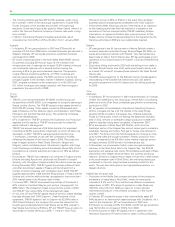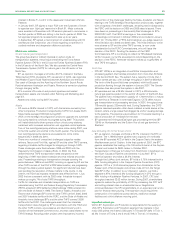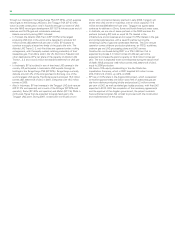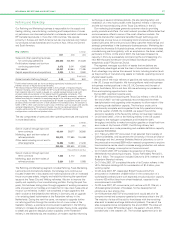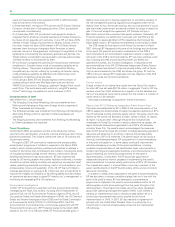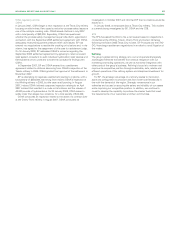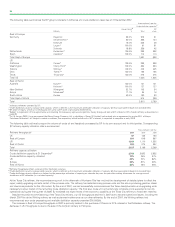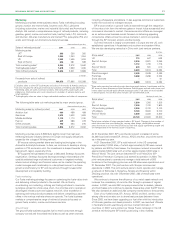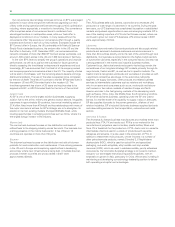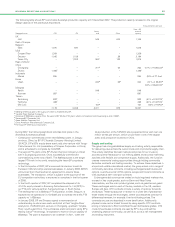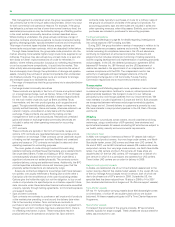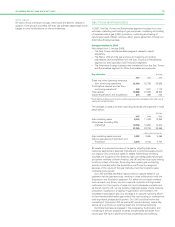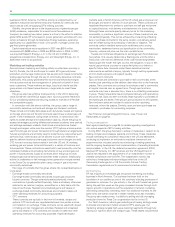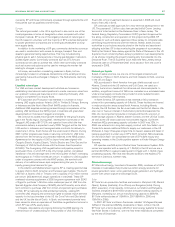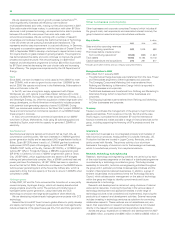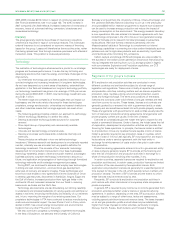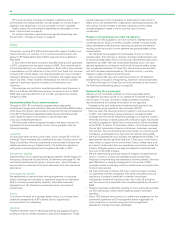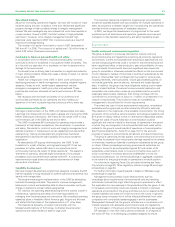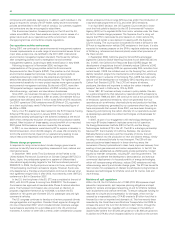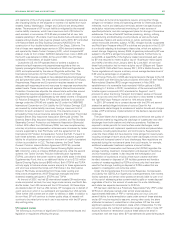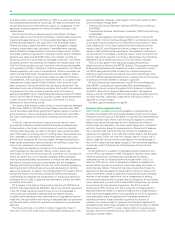BP 2007 Annual Report Download - page 36
Download and view the complete annual report
Please find page 36 of the 2007 BP annual report below. You can navigate through the pages in the report by either clicking on the pages listed below, or by using the keyword search tool below to find specific information within the annual report.
34
Risk management is undertaken when the group is exposed to market
risk, primarily due to the timing of sales and purchases, which may occur
for both commercial and operational reasons. For example, if the group
has delayed a purchase and has a lower-than-normal inventory level, the
associated price exposure may be limited by taking an offsetting position
in the most suitable commodity derivative contract described above.
Where trading is undertaken, the group actively combines a range of
derivative contracts and physical positions to create incremental trading
gains by arbitraging prices, typically between locations and time periods.
This range of contract types includes futures, swaps, options and
forward sale and purchase contracts, which are described further below.
Through these transactions, the group sells crude production into the
market, allowing more suitable higher-margin crude to be supplied to our
refineries. The group may also actively buy and sell crude on a spot and
term basis to further improve selections of crude for refineries. In
addition, where refinery production is surplus to marketing requirements
or can be sourced more competitively, it is sold into the market. This
latter activity also encompasses opportunities to maximize the value of
the whole supply chain through the optimization of storage and pipeline
assets, including the purchase of product components that are blended
into finished products. The group also owns and contracts for storage
and transport capacity to facilitate this activity.
The range of transactions that the group enters into is described below
in more detail:
– Exchange-traded commodity derivatives
These contracts are typically in the form of futures and options traded
on a recognized exchange, such as Nymex, Simex, ICE and Chicago
Board of Trade. Such contracts are traded in standard specifications
for the main marker crude oils, such as Brent and West Texas
Intermediate, and the main product grades, such as gasoline and
gasoil. Though potentially settled physically, these contracts are
typically settled financially. Gains and losses, otherwise referred to as
variation margins, are settled on a daily basis with the relevant
exchange. These contracts are used for the trading and risk
management of both crude and products. Realized and unrealized
gains and losses on exchange-traded commodity derivatives are
included in sales and other operating revenues for accounting
purposes.
– OTC contracts
These contracts are typically in the form of forwards, swaps and
options. OTC contracts are negotiated between two parties and are
not traded on an exchange. These contracts can be used both as part
of trading and risk management activities. Realized and unrealized
gains and losses on OTC contracts are included in sales and other
operating revenues for accounting purposes.
The main grades of crude oil bought and sold forward using
standard contracts are West Texas Intermediate and a standard North
Sea crude blend (Brent, Forties and Osberg or BFO). Although the
contracts specify physical delivery terms for each crude blend, a
significant volume are not settled physically. The contracts contain
standard delivery, pricing and settlement terms. Additionally, the BFO
contract specifies a standard volume and tolerance given that the
physically settled transactions are delivered by cargo.
Swaps are contractual obligations to exchange cash flows between
two parties: one usually references a floating price and the other a
fixed price with the net difference of the cash flows being settled.
Options give the holder the right, but not the obligation, to buy or sell
crude or oil products at a specified price on or before a specific future
date. Amounts under these derivative financial instruments are settled
at expiry, typically through netting agreements, to limit credit exposure
and support liquidity.
– Spot and term contracts
Spot contracts are contracts to purchase or sell crude and oil products
at the market price prevailing on and around the delivery date when
title to the inventory is taken. Term contracts are contracts to
purchase or sell a commodity at regular intervals over an agreed term.
Though spot and term contracts may have a standard form, there is
no offsetting mechanism in place. These transactions result in
physical delivery with operational and price risk. Spot and term
contracts relate typically to purchases of crude for a refinery, sales of
the group’s oil production and sales of the group’s oil products. For
accounting purposes, spot and term sales are included in sales and
other operating revenues, when title passes. Similarly, spot and term
purchases are included in purchases for accounting purposes.
Trading investigations
See Legal proceedings on page 84 for details regarding investigations
into various aspects of BP’s trading activities.
During 2007, the group has taken a series of measures in relation to its
trading compliance processes, systems and controls. These measures
include increasing its compliance resources in the US and elsewhere,
continuing to implement an enhanced compliance framework and
programme that includes compliance monitoring of trading operations,
and the ongoing development and implementation of operating standards
and processes. In the US, the deferred prosecution agreement (DPA)
between BP America Inc. (BP America) and the US Department of
Justice has resulted in the appointment of an independent monitor to
oversee compliance with the DPA. The independent monitor has
authority to investigate and report alleged violations of the US
Commodity Exchange Act or US Commodity Futures Trading
Commission regulations and to recommend corrective action.
Transportation
Our Refining and Marketing segment owns, operates or has an interest
in extensive transportation facilities for crude oil, refined products and
petrochemicals feedstock. We transport crude oil to our refineries
principally by ship and through pipelines from our import terminals. We
have interests in crude oil pipelines in Europe and the US. Bulk products
are transported between refineries and storage terminals by pipeline,
ship, barge and rail. Onward delivery to customers is primarily by road.
We have interests in major product pipelines in the UK, Rest of Europe
and the US.
Shipping
We transport our products across oceans, around coastlines and along
waterways, using a combination of BP-operated, time-chartered and
spot-chartered vessels. All vessels conducting BP activities are subject to
our health, safety, security and environmental requirements.
International fleet
In 2006, we managed an international fleet of 57 vessels (42 medium-
size crude and product carriers, four very large crude carriers, one North
Sea shuttle tanker, seven LNG carriers and three new LPG carriers). At
the end of 2007, we had 53 international vessels (39 medium-size crude
and product carriers, four very large crude carriers, one North Sea shuttle
tanker, five LNG carriers and four LPG carriers). All these ships are
double-hulled. Of the five LNG carriers, BP manages one on behalf of a
joint venture in which it is a participant and operates four LNG carriers.
Three further LNG carriers are on order for delivery in 2008.
Regional and specialist vessels
In Alaska, we redelivered one of our time-chartered vessels back to the
owner, leaving a fleet of five double-hulled vessels. In the Lower 48, two
of the four heritage Amoco barges remain in service, both of which are
due to be phased out of BP’s service in 2008. Outside the US, the
specialist fleet has been reduced from 16 ships in 2006 to 14 in 2007
(two double-hulled lubricants oil barges and 12 offshore support vessels).
Time-charter vessels
BP has 111 hydrocarbon-carrying vessels above 600 deadweight tonnes
on time-charter, of which 97 are double-hulled and two are double-
bottomed. All these vessels participate in BP’s Time Charter Assurance
Programme.
Spot-charter vessels
To transport the remainder of the group’s products, BP spot-charters
vessels, typically for single voyages. These vessels are always vetted for
safety assurance prior to use.


